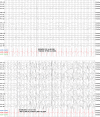Nodding syndrome in Ugandan children--clinical features, brain imaging and complications: a case series
- PMID: 23645924
- PMCID: PMC3646179
- DOI: 10.1136/bmjopen-2012-002540
Nodding syndrome in Ugandan children--clinical features, brain imaging and complications: a case series
Abstract
Objectives: Nodding syndrome is a devastating neurological disorder of uncertain aetiology affecting children in Africa. There is no diagnostic test, and risk factors and symptoms that would allow early diagnosis are poorly documented. This study aimed to describe the clinical, electrophysiological and brain imaging (MRI) features and complications of nodding syndrome in Ugandan children.
Design: Case series.
Participants: 22 children with nodding syndrome brought to Mulago National Referral Hospital for assessment.
Outcome measures: Clinical features, physical and functional disabilities, EEG and brain MRI findings and a staging system with a progressive development of symptoms and complications.
Results: The median age of symptom onset was 6 (range 4-10) years and median duration of symptoms was 8.5 (range 2-11) years. 16 of 22 families reported multiple affected children. Physical manifestations and complications included stunting, wasting, lip changes and gross physical deformities. The bone age was delayed by 2 (range 1-6) years. There was peripheral muscle wasting and progressive generalised wasting. Four children had nodding as the only seizure type; 18 in addition had myoclonic, absence and/or generalised tonic-clonic seizures developing 1-3 years after the onset of illness. Psychiatric manifestations included wandering, aggression, depression and disordered perception. Cognitive assessment in three children demonstrated profound impairment. The EEG was abnormal in all, suggesting symptomatic generalised epilepsy in the majority. There were different degrees of cortical and cerebellar atrophy on brain MRI, but no hippocampal changes. Five stages with worsening physical, EEG and brain imaging features were identified: a prodrome, the development of head nodding and cognitive decline, other seizure types, multiple complications and severe disability.
Conclusions: Nodding syndrome is a neurological disorder that may be characterised as probably symptomatic generalised epilepsy. Clinical manifestations and complications develop in stages which might be useful in defining treatment and rehabilitation. Studies of risk factors, pathogenesis, management and outcome are urgently needed.
Figures


References
-
- Korevaar DA, Visser BJ. Reviewing the evidence on nodding syndrome, a mysterious tropical disorder. Int J Infect Dis 2013;17:e149–52 - PubMed
-
- Aall L. Epilepsy in Tanganyika. Review and Newsletter- Transcult Res Mental Hlth Probl 1962;13:54–7
-
- Goudsmit J, van der Waals FW. Endemic epilepsy in an isolated region of Liberia. Lancet 1983;1:528–9 - PubMed
-
- Lacey M. Nodding disease: mystery of southern Sudan. Lancet Neurol 2003;2:714. - PubMed
-
- Centers of Disease Control. Nodding syndrome—South Sudan, 2011. MMWR Morb Mortal Wkly Rep 2012;61:52–4 - PubMed
Grants and funding
LinkOut - more resources
Full Text Sources
Other Literature Sources
